Research
Research by the PHRAGMITES group centres around five main themes: the spread of the common reed, the impacts of common reed on biodiversity, the impacts of climate change on the common reed, controlling populations of common reed and the use of common reed as a filtering system. Two articles for the general public (in French), the first on the origins of the common reed invasion and the second on the consequences of the invasion and ways to mitigate them, give an overview of the group’s research. In the sections below, completed and on-going research are briefly presented.
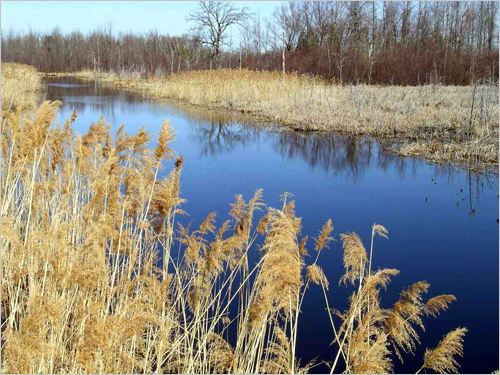
Common reed populations expanding along a body of water (photo: J. Brisson).
1) SPREAD OF THE COMMON REED
The common reed spreads by seeds, which are transported by wind and water, and by pieces of stems and rhizomes that are transported from one area to another by water or by heavy machinery during soil excavation. For many years, the PHRAGMITES group has been interested in the processes that permit the plant to spread rapidly over large areas. The group is working on seed viability studies, and on the characteristics of marshes, road networks or lakes that favour the germination of these seeds. Many examples of these studies can be found in the section Publications, the most significant being those resulting from research directed by François Belzile, Sylvie de Blois and Claude Lavoie (click on the names to consult the examples).
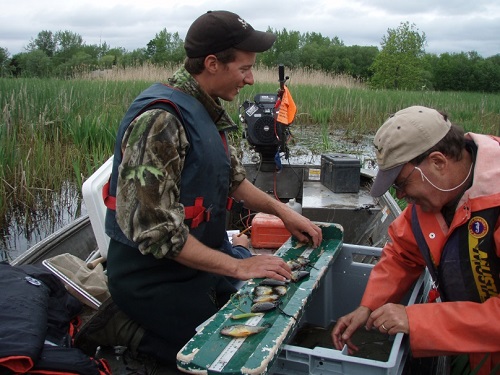
Two biologists examining an experimental fish capture in a common reed population (photo: C. Lavoie)
2) IMPACTS OF COMMON REED ON BIODIVERSITY
Common reed forms very dense populations in which plant diversity is extremely poor. In marshes, common reed may have negative impacts on fish, amphibians and birds that use wetlands to feed and reproduce. The PHRAGMITES group has performed many large scale studies on the fauna over the last few years. Examples of these studies done in collaboration with researchers such as Pierre Dumont and Daniel Hatin (fish), Marc Mazerolle (amphibians) and Gilles Gauthier (birds) may be found in the Publications section (click on the names to consult these examples).
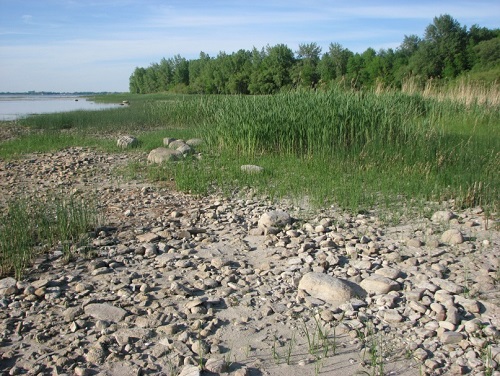
An exposed lakeshore, an ideal habitat for the expansion of the common reed by seed (photo: C. Lavoie)
3) IMPACTS OF CLIMATE CHANGE ON COMMON REED
The common reed is a plant that produces its seeds at the end of the summer and the beginning of the fall. The seeds are thus exposed to the first fall frosts, which may reduce their viability. If the climate warms and the growing season lengthens, the seeds will have more time to reach maturity, which will increase the invasive potential of the plant. Also, climate warming will likely lower the water level in the Saint-Lawrence river, exposing clayey banks ideal for seed germination. Concern thus exists that common reed populations will rapidly expand in the near future, in a climate that is hotter and drier. In the Publications sections are two examples of research on this topic, directed by Sylvie de Blois and Claude Lavoie and Jean Morin (click on the names to consult these examples).
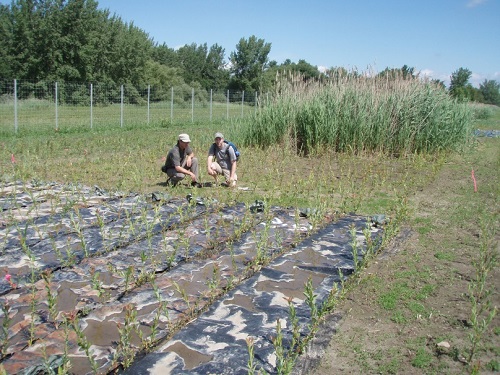
Experiments on the eradication and control of common reed in the Îles-de-Boucherville national park (photo: C. Lavoie).
4) COMMON REED CONTROL
Controlling the expansion of a common reed colony, let alone complete eradication is a very difficult task, especially in Quebec where the use of herbicides is prohibited in wetlands. The PHRAGMITES group is focussing its efforts on the prevention of invasions, notably by eliminating germination beds along roads or in fallow fields. The team uses competitive shrubs (willow, alder) to smother common reed seedling in their first year of life. Large scale tests have been carried out in marshes, along certain roads and in fallow fields. Jacques Brisson‘s team, assisted by Patrick Boivin, have performed most of these studies, which may be consulted in the Publications section (click on the names to see the examples).
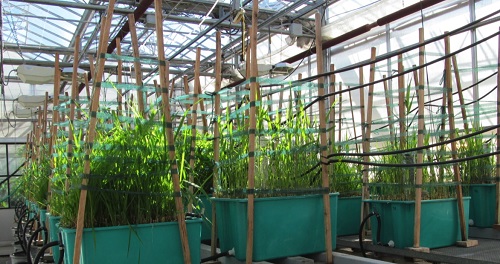
Water treatment experiment using common reed (photo: M. Rodriguez).
5) FILTERING MARSHES
Although the common reed is an invasive plant, it also has tremendous wastewater purification potential. Research by the PHRAGMITES group does not aim to promote the use of common reed in filtering marshes, but rather to find, using comparative studies, other plants or combinations of plants that could be valid alternatives for filtration systems. Research on this subject is carried out under the supervision of Jacques Brisson (click on his name to see an example; other articles are available in the Publications section).